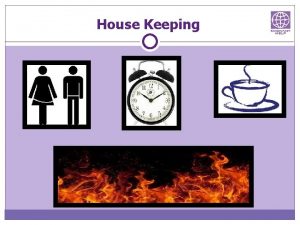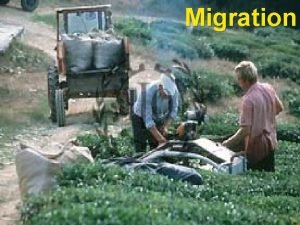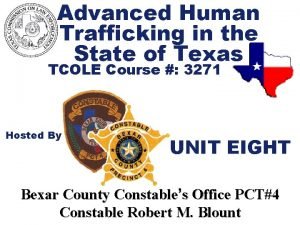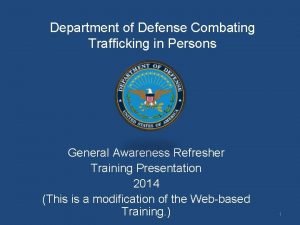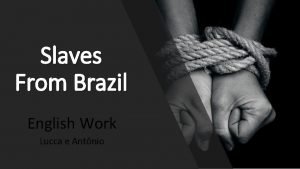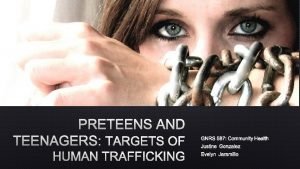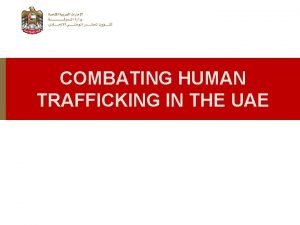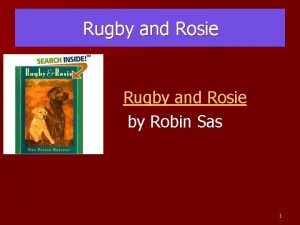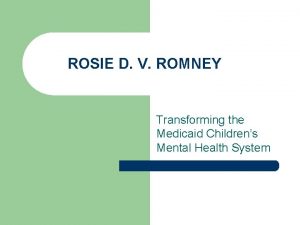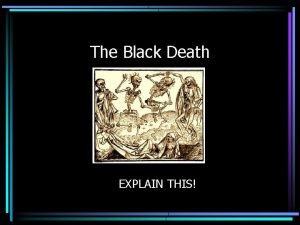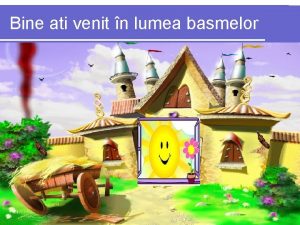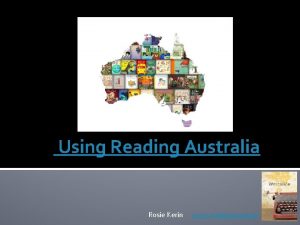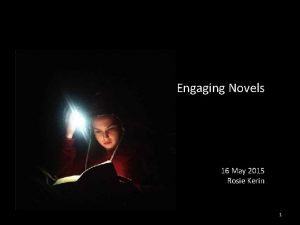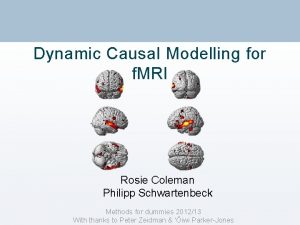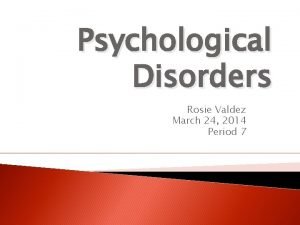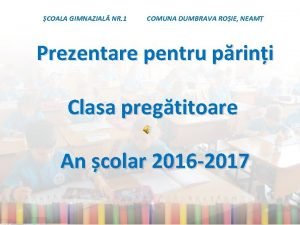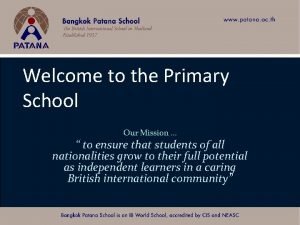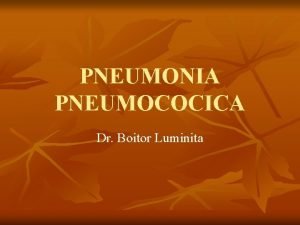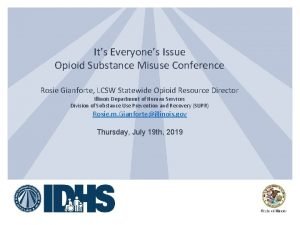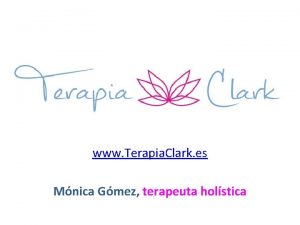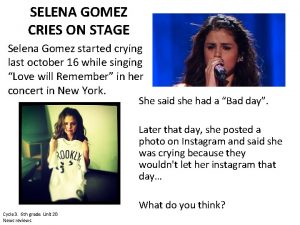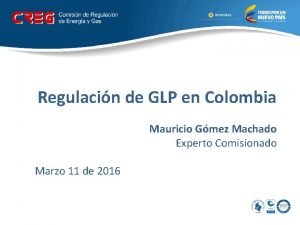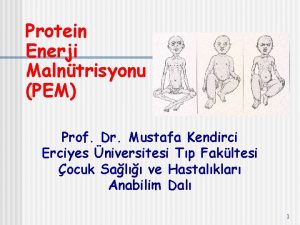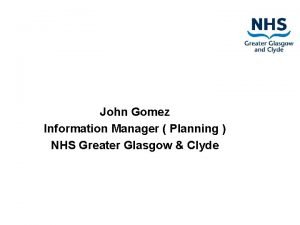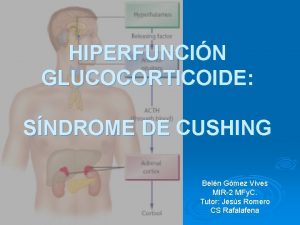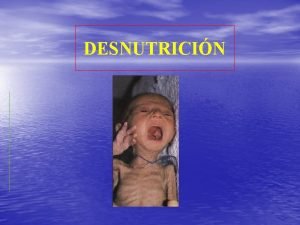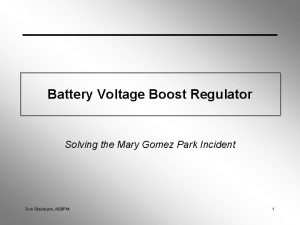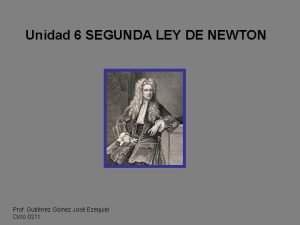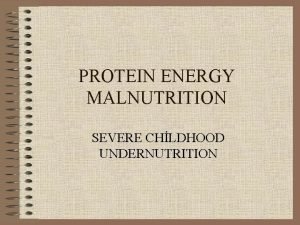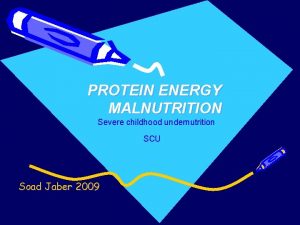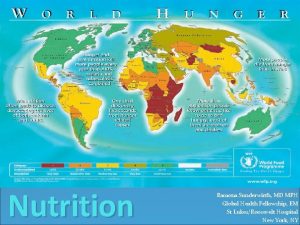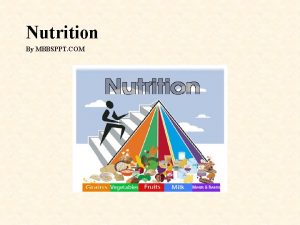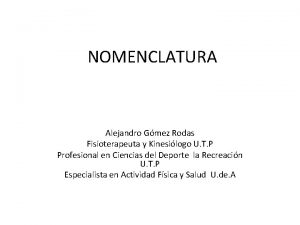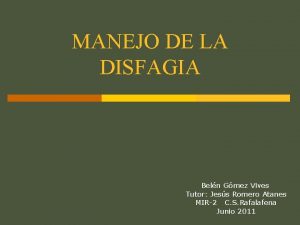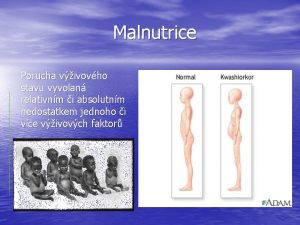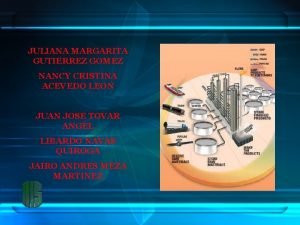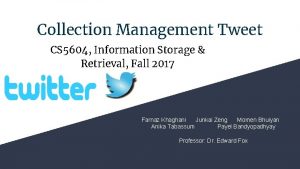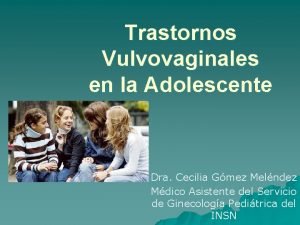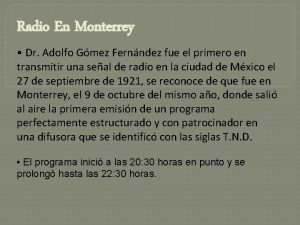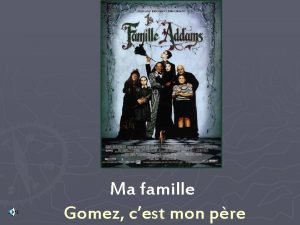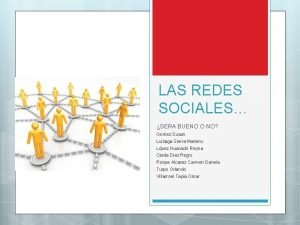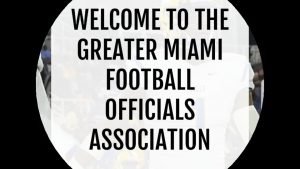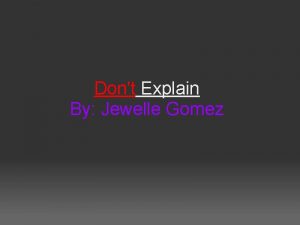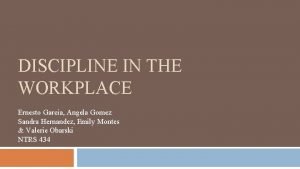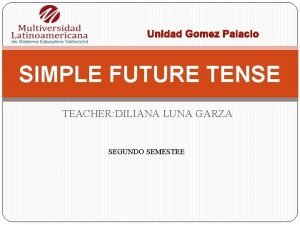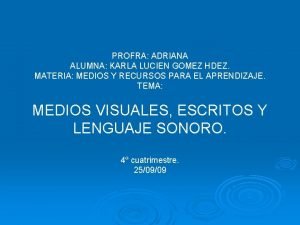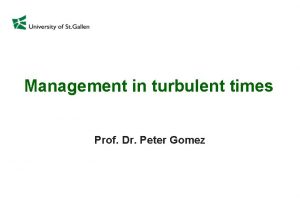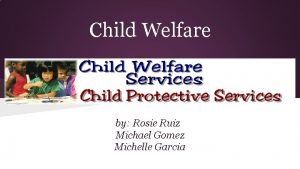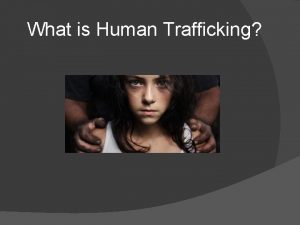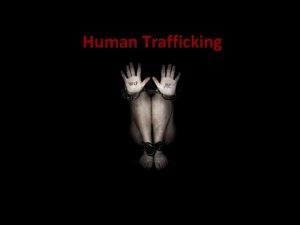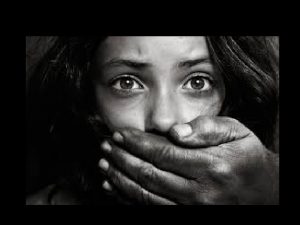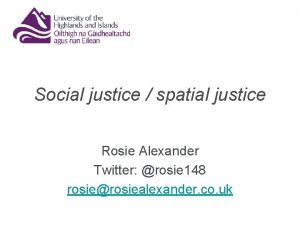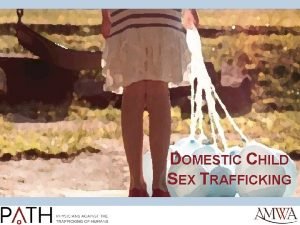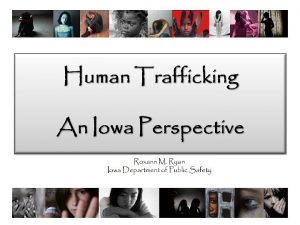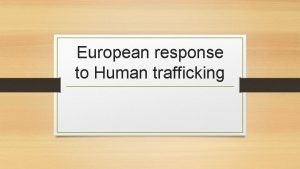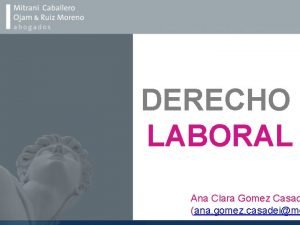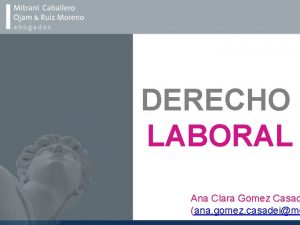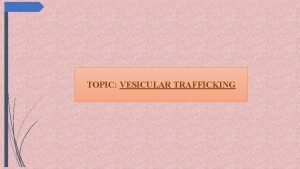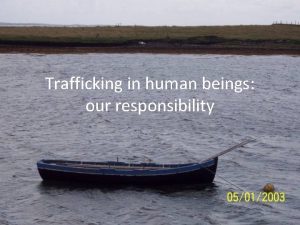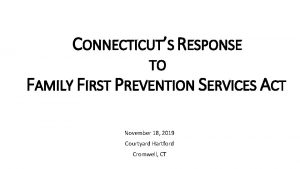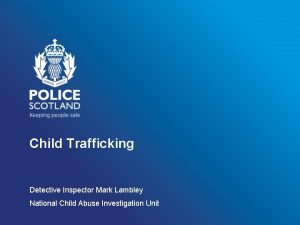Connecticuts Response to Child Trafficking Introduction Rosie Gomez





![Over 42, 000 Human Trafficking Hotline Cases Identified & Responded To [12/2007 -5/2018] Over 42, 000 Human Trafficking Hotline Cases Identified & Responded To [12/2007 -5/2018]](https://slidetodoc.com/presentation_image_h/c049f9a61f00ea1777c78d3703cf6069/image-6.jpg)
![12, 900+ HT Cases Involving Minors [12/2007 -5/2018] 10, 383 1, 427 SEX TRAFFICKING 12, 900+ HT Cases Involving Minors [12/2007 -5/2018] 10, 383 1, 427 SEX TRAFFICKING](https://slidetodoc.com/presentation_image_h/c049f9a61f00ea1777c78d3703cf6069/image-7.jpg)










![2017 Race/Ethnicity 3% 1% 1% Race/Ethnicity 10% Hispanic Caucasian 40% [VALUE] African American/Black Multi-racial 2017 Race/Ethnicity 3% 1% 1% Race/Ethnicity 10% Hispanic Caucasian 40% [VALUE] African American/Black Multi-racial](https://slidetodoc.com/presentation_image_h/c049f9a61f00ea1777c78d3703cf6069/image-18.jpg)







































![Demographics: Gender & Years of Experience Other/Transgender [VALUE] Years of Experience (n=2, 075) Male Demographics: Gender & Years of Experience Other/Transgender [VALUE] Years of Experience (n=2, 075) Male](https://slidetodoc.com/presentation_image_h/c049f9a61f00ea1777c78d3703cf6069/image-58.jpg)










![Be. Free Text. Line [233733] In 2012, Thorn completed a survey of U. S. Be. Free Text. Line [233733] In 2012, Thorn completed a survey of U. S.](https://slidetodoc.com/presentation_image_h/c049f9a61f00ea1777c78d3703cf6069/image-69.jpg)











- Slides: 80

Connecticut’s Response to Child Trafficking

Introduction Rosie Gomez Child Welfare Program Specialist Administration for Children and Families, ACYF, CB

Trafficking from a National Perspective Vanessa Chauhan Polaris ICF proprietary and confidential. Do not copy, distribute, or disclose.

Federal Law – Trafficking Victims Protection Act Sex Trafficking Labor Trafficking The recruitment, harboring, transportation, provision, obtaining, patronizing, soliciting, or advertising of a person for a commercial sex act, in which a commercial sex act is induced by force, fraud, or coercion, or in which the person induced to perform such an act has not attained 18 years of age. The recruitment, harboring, transportation, provision, or obtaining of a person for labor or services, through the use of force, fraud, or coercion for the purpose of subjection to involuntary servitude, peonage, debt bondage, or slavery.

Action-Means-Purpose (AMP) Model
![Over 42 000 Human Trafficking Hotline Cases Identified Responded To 122007 52018 Over 42, 000 Human Trafficking Hotline Cases Identified & Responded To [12/2007 -5/2018]](https://slidetodoc.com/presentation_image_h/c049f9a61f00ea1777c78d3703cf6069/image-6.jpg)
Over 42, 000 Human Trafficking Hotline Cases Identified & Responded To [12/2007 -5/2018]
![12 900 HT Cases Involving Minors 122007 52018 10 383 1 427 SEX TRAFFICKING 12, 900+ HT Cases Involving Minors [12/2007 -5/2018] 10, 383 1, 427 SEX TRAFFICKING](https://slidetodoc.com/presentation_image_h/c049f9a61f00ea1777c78d3703cf6069/image-7.jpg)
12, 900+ HT Cases Involving Minors [12/2007 -5/2018] 10, 383 1, 427 SEX TRAFFICKING CASES LABOR TRAFFICKING CASES 409 738 SEX & LABOR TRAFFICKING CASES OTHER/NOT SPECIFIED CASES

Top 5 Venues for Trafficking of Minors Sex Trafficking Labor Trafficking Internet-Based Commercial Sex Peddling Rings Hotel/Motel-Based Commercial Sex Traveling Sales Crews Residence-Based Commercial Sex Begging Rings Pornography Domestic Work Street-Based Commercial Sex Restaurant/Food Service

Connecticut’s Response to Trafficking Tammy Sneed Department of Children & Families ICF proprietary and confidential. Do not copy, distribute, or disclose.

Definitions • Department of Children and Families (DCF) – CT state child welfare agency • Human Antitrafficking Response Team (HART) – statewide partnership addressing child trafficking • Human Trafficking Task Force – The Task Force with oversight from the USAO consists of federal, state, and local law enforcement officers and prosecutors who triage and investigate human trafficking leads • Domestic Minor Sex Trafficking (DMST) – is the exchange of any sex act of a minor (child under 18) for anything of value, in the U. S. • Multi-disciplinary Team (MDT) - Multi-disciplinary teams (MDT) comprise of professionals involved in investigating cases of child abuse and neglect, prosecution of child abuse and neglect cases in court, and provision of treatment services to victims • Child Advocacy Center (CAC) – the safe, child focused setting in which the supports and services are offered to the children and non-offending parent or caregiver

Connecticut Structure

DCF Districts

Connecticut Flow Chart – Call into Careline HART Liaison Provides Consult Local Law Enforcement Call into Careline Report to HART Director Report to Regional Liaison(s) HART Director Reviews and Includes Partners Linked to Specialized Services Human Trafficking Task Force (USAO) Multidisciplinary Team(s)

Connecticut Flow Chart – Request for HART Consult HART Liaison Provides Consult Human Trafficking Task Force (USAO) & Local Law Enforcement Request for a HART Consult (active DCF Cases) Multidisciplinary Team(s) HART Director Reviews

HART Organization Chart Chapter Director CT Children’s Alliance Service Providers Law Enforcement Medical New Resources & Funding HART Director DCF School Outreach HART Liaisons Advocates State Agencies Public Awareness & Job Specific Training HART Coordinator HART Liaison DCF MDT Coordinators Emergency Medical Services Placement Options & Availability Faith Based Attorneys Homeless Youth Advocates Survivor Informed Practice & Engagement Labor Trafficking

Trafficking Legislation in Connecticut • Minors under the age of 18 cannot be arrested for prostitution • Victims of DMST are guaranteed an affirmative defense, and have the right to vacate related juvenile records • Victims of DMST can be classified as “uncared for” in order for DCF to provide services • Suspected cases of DMST shall be reported to the DCF Careline (800 -842 -2288) • DMST cases are to be addressed through Multi-disciplinary Teams (MDTs) • Buyers paying to sexually abuse a child can be charged with Commercial Sexual Abuse of a Minor; this crime is a Class B felony when the child being purchased is age 15 to 17 and Class A felony when the child is under the age of 15

Referrals by Year January 1, 2008 – December 31, 2017 n=846 250 212 200 195 184 150 133 94 100 122 92 79 50 44 36 26 18 2 2 0 2008 2009 2010 2011 Number of Referrals 2012 Number of Boys 2013 Number of Girls 2014 0 10 2015 Number of Transgendered 17 1 2016 0 2017
![2017 RaceEthnicity 3 1 1 RaceEthnicity 10 Hispanic Caucasian 40 VALUE African AmericanBlack Multiracial 2017 Race/Ethnicity 3% 1% 1% Race/Ethnicity 10% Hispanic Caucasian 40% [VALUE] African American/Black Multi-racial](https://slidetodoc.com/presentation_image_h/c049f9a61f00ea1777c78d3703cf6069/image-18.jpg)
2017 Race/Ethnicity 3% 1% 1% Race/Ethnicity 10% Hispanic Caucasian 40% [VALUE] African American/Black Multi-racial Unknown Asian Other 29% Number Hispanic 84 Caucasian 62 African American/Black 34 Multi-racial 21 Unknown 6 Asian 3 Other 2

2017 Age at time of Victimization 2% 2% 3% Age 15 to 16 15% 13 to 14 41% 17 to 18 Unknown 11 to 12 18% 10 and Under Over 18 21% Number 10 and Under 5 11 to 12 7 13 to 14 43 15 to 16 84 17 to 18 37 Over 18 4 Unknown 32

2017 Residence at Time of Exploitation 2% Residence Parent/Guardian Home 9% AWOL/Runaway 10% Foster home 12% 67% Congregate care Relative/Other Home Parent/Guardian Home Number 141 AWOL/Runaway 26 Foster home 22 Congregate care 19 Relative/Other Home 4 Detention 0 Shelter 0 Missing/Unknown 0

HART Response and Resources Christa Rider Department of Children & Families ICF proprietary and confidential. Do not copy, distribute, or disclose.

HART Case Example • 17 year old female • DMST Victim • No Law Enforcement Involvement • Attorney would not consent for youth to engage in services • Youth was arrested and detained multiple times and ended up on Juvenile Parole

DCF Regional HARTs

Regional HART Response Area Office Case referred to HART Liaison to complete DCF HART Decision Map Consultation with the Human Trafficking Task Force, if needed Case may be triaged with the Area Office HART Team Multidisciplinary Team (MDT) Child Advocacy Center (CAC) Services and Support Offered to Meet Individualized Needs Individualized Goals Achieved DCF Case Closes

Existing Resources in CT • Youth Awareness: 45 to 60 minute Youth Awareness presentation to educate youth ages 12 to 18 on child trafficking; can be done in assembly format • Not a #Number: 5 session prevention curriculum developed by Love 146 on Human Trafficking for girls, boys and LGBTQI youth, ages 12 to 18 • My Life My Choice: 10 -session Exploitation Prevention Curriculum designed to change girls’ (ages 12 to 18) perceptions of the commercial sex industry, as well as build selfesteem and personal empowerment • Survivor Care – Rapid Response: Rapid Responses are one-time interventions designed to target the unique risk factors and needs of individual youth who have been identified as confirmed victims, or highly suspected victims of human trafficking • Survivor Care – Long Term: Love 146’s Survivor Care Therapeutic Case Management Program journeys with and provides support services to youth who are confirmed survivors of human trafficking

Existing Resources in CT • Foster Care: there are Therapeutic Foster Parents who are trained to provide support and placement for youth at high risk and/or confirmed victims of DMST in CT • Mentoring: there are DMST trained mentors in CT • Wilderness School: specialized events in partnership with Love 146/ Survivor Care • Connecticut’s Provider Network: providers are trained on child trafficking, service provision is based on the need of each individual youth

Collaboration in CT: Child Advocacy Centers and MDTs Krystal Rich Connecticut Children’s Alliance ICF proprietary and confidential. Do not copy, distribute, or disclose.

Child Advocacy Centers and Multi-disciplinary Teams • What is a MDT? • Multi-disciplinary teams (MDT) comprise of professionals involved in investigating cases of child abuse and neglect, prosecution of child abuse and neglect cases in court, and provision of treatment services to victims. • What is a CAC? • The safe, child focused setting in which the supports and services are offered to the children and non-offending parent or caregiver. • What is the purpose of this model? • To ensure better collaboration • Reducing the risk of breakdown in communication • Ensure the system set up to protect and respond to kids doesn’t revictimize them by reducing duplication of services and work to achieve a best practice response

CACs and MDTs in CT • How many CACs and MDTs? • 10 Child Advocacy Centers • 17 Multi-disciplinary Teams • What does this mean? • Every abused child in CT has access to the comprehensive and collaborative response no matter where they live. • What are there 10 CACs and 17 MDTs? • Some of our CACs collaborate with 1 MDT and 2 CACs collaborate with more than 1 MDT. This formula was created based on several variable including our judicial districts, DCF districts as well as population.

CAC Standards • • • Multi-disciplinary Team Cultural Competency and Diversity Forensic Interviews Victim Support and Advocacy Medical Evaluation Mental Health Case Review Case Tracking Organizational Capacity Child-Focused Setting

How does the Children’s Advocacy Center Model Work?

MDT/ CAC and Child Trafficking Cases CAC and MDT Structure for Cases MDT and Coordinator HART Child Advocacy Center Task Force Child Advocacy Center

MDT/ CAC and Child Trafficking Cases • Legislation Updates: • Public Act (14 -186) Mandated an MDT Response be made available to all victims of child trafficking • Public Act (17 -190) Updated the Child Advocacy Center and MDT case criteria and services standards • Outcome Measurement System (OMS) Data: • A satisfaction systems designed to gather information from caregivers and MDT partners to better inform our systems response

MDT Partner OMS Data 2016 - As a member of a Multi-disciplinary Team in CT, I have a clear understanding of my role addressing cases of domestic minor sex trafficking (DMST). Agree 34 109 171 175 2017 - As a member of a Multi-disciplinary Team in CT, I have a clear understanding of my role addressing cases of domestic minor sex trafficking (DMST). 436 Disagree 721 N/A Agree Disagree N/A

MDT Partner OMS Data In 2016: • 46% of MDT partners felt there were enough services to support DMST victims in CT • 56% of MDT partners felt they had a clear understanding of the system set up to respond to DMST victims in CT In 2017: • 71% of MDT partners felt there were enough services to support DMST victims in CT • 81% of MDT partners felt they had a clear understanding of the system set up to respond to DMST victims in CT

Caregiver OMS Data 2016 - As a caregiver I feel I have enough information and services to support my child after our visit to the CAC. Agree 34 109 171 175 2017 - As a caregiver I feel I have enough information and services to support my child after our visit to the CAC. 436 Disagree 721 N/A Agree Disagree N/A

HART Response and Case Experiences Christa Rider Department of Children & Families ICF proprietary and confidential. Do not copy, distribute, or disclose.

HART Case Example • 16 year old female • DMST and Kidnapping Victim • Strong Law Enforcement Response • Youth was referred to MDT and completed a Forensic Interview • Creative with respect to how youth was supported during the process (i. e. psychiatric hospital, service providers, clinical supports present directly before and after Forensic Interview, etc. )

Youth Perspective Samantha Lowry ICF proprietary and confidential. Do not copy, distribute, or disclose.

Youth Survivor Perspective – Major Themes Youth survivors had a fear of law enforcement and expressed that their limited exposure was due to a lack of trust and negative experiences with being treated as criminals. Victims did not see police as a place for help. Comfort was paramount! Survivors desired a balance of rules and comfort given the important role that service providers play in their lives. The youth emphasized that an honest opinion was needed along with a longer term support system. The adults in their lives changed often and bonds were frequently broken. The message to Judges was to look beyond what is on paper and listen to the survivor’s perspective. Youth wanted to be more involved in the process and to speak directly to the Judge. “Judges typically lock up youth, ” which youth were open about and cited as the reason to continue running. Survivors overwhelmingly agreed that they did not have a say in the types of services received, nor did they feel in control of their own lives/care. ICF proprietary and confidential. Do not copy, distribute, or disclose.

75. 0 % of youth survivors had some prior knowledge of what the term “human trafficking” meant before their disclosure However, there was a striking disconnect between recognizing the term and understanding the various forms of human trafficking and how they relate to what the youth were experiencing. Youth Survivor Perspective How did youth survivors obtain knowledge about Human Trafficking? The places and people that taught these young survivors about human trafficking included: School presentations/ programs ICF proprietary and confidential. Do not copy, distribute, or disclose. Therapy/ Therapists Hospital staff Service providers

Youth Survivor Perspective When and how were they first identified as victims? Seven survivors were identified as victims later through disclosure while in care. One survivor was identified as a victim through a police sting. One survivor who was identified through a police sting shared that she had not heard of the term “human trafficking” until she was “caught in the sting” and officers explained the circumstances at the scene. Several stories were shared where youth could have been identified sooner if the people in their lives had a better understanding of human trafficking. ICF proprietary and confidential. Do not copy, distribute, or disclose.

Youth Survivor Perspective What types of services did youth survivors receive? A wide range of programs, organizations, behavioral health services, and trainings: in-home programs, probation, family therapy programs, detention facilities, the role of the Department of Children and Families from their viewpoint, Not a Number, My Life My Choice, involvement of school programs, and a variety of other systems and supports that provided some type of service. Based on comfort of survivors Victim Service Provider, Love 146: Known for the care backpacks and comforting staff that were “highly involved in [their] care. ” This was the only service that was described as long-term and unbounded, which youth found to be gravely important. ICF proprietary and confidential. Do not copy, distribute, or disclose. Based on safety of survivors Secure Detention Facility: Strict adherence to the rules and attentiveness to the youth’s needs, it was not a desired location according to survivors. Secure facilities made the youth feel more like victims and were similar to the control exerted by their traffickers.

Youth Survivor Recommendations #1: AWARENESS OF HUMAN TRAFFICKING Educate youth in schools through service providers or awareness events to help with reintegration into the school system and help eliminate bullying. Youth survivors also suggested that law enforcement should have more awareness of the needs of sex trafficking survivor that is treatment focused and trauma-informed. Survivors wanted parents and foster parents to become more comfortable and open to talking about bad situations, involved in their daily lives, and encouraging of healthy environments. “More awareness, even for those not in the life. Like for bullies. They’ll call me whore. I’ve had that happen to me… so, AWARENESS THAT PEOPLE ARE VICTIMS. ” ICF proprietary and confidential. Do not copy, distribute, or disclose.

Youth Survivor Recommendations #2: ACCESSIBILITY OF SERVICES Service providers should utilize a variety of methods to connect victims and at-risk youth with services so that a multitude of victims can be reached. Service providers need a more pronounced social media presence Half of the youth survivors suggested that service providers should have a more of a social media presences such as Facebook, Snapchat, blogs, websites, TED Talks, and apps for teens. ICF proprietary and confidential. Do not copy, distribute, or disclose. Law enforcement should become an immediate resource for survivors The youth survivors felt that law enforcement should be an available resource to them, however, a few of the youth had prior experiences where they had not been treated respectfully by police.

Youth Survivor Recommendations #3: COMPASSION AND HEALTHY RELATIONSHIPS Love 146 was the model program. The program and staff that did not judge, asked for the youth’s opinion, and offered unconditional support. Service providers should put less pressure on the survivors to talk right away and especially in group settings. Alternatively, more survivor led services and support groups that allowed survivors to talk with one another. Judges were also described as being less supportive of victims and another entity that was unwilling to allow the victim to speak about his/her experience. ICF proprietary and confidential. Do not copy, distribute, or disclose. Referrals should be more inclusive of the survivors’ thoughts and concerns, especially younger survivors who tended to feel like their voices were not heard. For law enforcement there should be survivor-led trainings on traumainformed responses and sexual exploitation to allow police to make more meaningful connections with victims.

Youth Survivor Demographics (n=8) Location Gender Age 17 years-old (37. 5%) 16 years-old (50. 0%) 15 years-old (12. 5%) Ethnicity Race African American Multiracial (12. 5%) (25. 0%) Caucasian (12. 5%) Multiethnic (62. 5%) (50. 0%) Puerto Rican Black (12. 5%) Hispanic (12. 5%) ICF proprietary and confidential. Do not copy, distribute, or disclose. White

Expansion and Statewide Training Initiatives Tammy Sneed Department of Children & Families ICF proprietary and confidential. Do not copy, distribute, or disclose.

Connecticut Curriculums • Introduction to DMST in Connecticut • Introduction to Human Trafficking in Connecticut for Law Enforcement (POST Certified) • Introduction to DMST in Connecticut for Emergency Medical Services (EMS) • Domestic Minor Sex Trafficking of Boys & Male Bodied Youth • HUMAN TRAFFICKING DAY 1 - Understanding commercial sexual exploitation of children and domestic minor sex trafficking • HUMAN TRAFFICKING DAY 2 - Working with youth at risk of CSEC/DMST as well as Labor Trafficking by helping Staff understand engage with child victims • Fostering in the best & hardest of times: Helping foster parents care for high risk kids and child victims of commercial sexual exploitation • Youth Awareness on DMST • Youth Prevention - Not a #Number (Love 146 https: //love 146. org/ )

Statewide Awareness Efforts 2016 to Present • Reported Trainings: • General Training Sessions – 305 • Individual Attendees – 7, 440 • Law Enforcement Training Sessions – 55 • Officer Attendees – 1, 120 • School Training Sessions – 52 • Student Focused – 33 • Teacher Focused – 19 • Youth Awareness – 761 youth • Not a #Number (youth prevention) • 93 groups with 572 youth • Annual Conference

TO PREVENT THE EXPLOITATION OF CHILDREN we must reach them before traffickers do. DEVELOPED BY Love 146: https: //love 146. org/notanumber/ Youth Prevention Curriculum 12 Not a #Number Facilitator Trainings in CT to date (3 -days) Approximately 117 facilitators in CT educating youth (5 -sessions)

Training of Trainers (TOT) • More than 15 Training of Trainers (TOT) Courses • 2 full days each • Classroom Teach Back • Live Teach Back • 152 Trainers Statewide • 87 Trainees to complete Live Teach Back • Faculty Meetings Annually • Review what is working and what is not working • Newest research, data, etc. • Curriculum Updates • HHS ACF Pre and Post Surveys Training Coordinator

Training Evaluation Samantha Lowry ICF proprietary and confidential. Do not copy, distribute, or disclose.

Awareness of Sex Trafficking Surveys collected from October 2014 through June 2017 4, 865 total surveys from 97 training events 2, 448 surveys before the training (Pre-tests) 2, 417 surveys after the training (Post-tests)

Demographics: Trainee’s Field of Work (n=2, 286) 30% Education 14% Child Welfare 11% Service Provider 9% Law Enforcement 2% Juvenile Justice Community Member 1% Legal Community 1% 28% Other* 0% 20% 40% 60% 80% 100% *Common “Other” responses include “Student, ” “Mental Health, ” “Clinician, ” and “Nurse. ” 55

Demographics: Trainee’s Position at Current Organization (n=2, 255) 15% Teacher 12% 11% Law Enforcement Officer Mental Health Provider 9% Caseworker 5% 4% 4% 3% 3% 2% 2% 1% 1% Counselor Foster Parent Local-Level Supervisor/Administrator Child Protective Investigator Foster Care Provider Probation Officer Nurse Victim Advocate Doctor 30% Other* 0% 10% 20% 30% 40% *Common “Other” responses include “Student, ” “Paraprofessional, ” and “Social Worker” 56

Demographics: Race & Ethnicity 67% Caucasian 14% African American 12% Hispanic/Latino(a) 3% Multiple Asian/Pacific Islander (n=2, 366) 1% 3% Other 0% 20% 40% 60% 80% 100% 57
![Demographics Gender Years of Experience OtherTransgender VALUE Years of Experience n2 075 Male Demographics: Gender & Years of Experience Other/Transgender [VALUE] Years of Experience (n=2, 075) Male](https://slidetodoc.com/presentation_image_h/c049f9a61f00ea1777c78d3703cf6069/image-58.jpg)
Demographics: Gender & Years of Experience Other/Transgender [VALUE] Years of Experience (n=2, 075) Male 23% Female [VALUE] 0 -2 years 14% 3 -5 years 17% 6 -10 years 23% 11 -20 years 31% 21+ years 15% Gender (n=2, 411) 58

Survey Constructs: • Level of Knowledge (e. g. risk factors, definitions and terminology) – 12 items rated on a scale of 1 to 5; Maximum potential score = 60 • • Beliefs (e. g. victim culpability) – 4 items rated on a scale of 1 to 10; Maximum potential score = 40 Level of Comfort (e. g. self-efficacy, confidence in practice) – 6 items rated on a scale of 1 to 10; Maximum potential score = 60 59

Preliminary Scores Construct Average Knowledge Average Beliefs Average Comfort (n=1, 504) Average BEFORE the Training Average AFTER the Training Significant Difference 2. 1 A Little Knowledge 3. 4 Knowledgeable ** 2. 6 False 2. 2 Very False ** 4. 6 A Little Uncomfortable 6. 1 Very Comfortable ** * Indicates the difference between means is statistically significant, p<. 05 ** Indicates the difference between means is statistically significant, p<. 01 60

Level of Knowledge by Field of Work Average Scores BEFORE Average Scores AFTER Child Welfare 2. 6 A Little Knowledge 3. 7 Advanced Knowledge Education 1. 8 A Little Knowledge 3. 2 Knowledgeable Law Enforcement 2. 0 A Little Knowledge 3. 2 Knowledgeable Service Provider 2. 4 A Little Knowledge 3. 6 Advanced Knowledgeable All Fields of Work 2. 1 A Little Knowledge 3. 4 Knowledgeable 61

Beliefs by Field of Work Average Scores BEFORE Average Scores AFTER Child Welfare 2. 3 Very False 1. 6 Very False Education 2. 7 False 2. 5 False Law Enforcement 2. 7 False 2. 4 Very False Service Provider 2. 4 Very False Across all Fields of Work 2. 6 False 2. 2 Very False 62

Level of Comfort by Field of Work Average Scores BEFORE Average Scores AFTER Child Welfare 5. 7 A Little Uncomfortable 7. 2 Very Comfortable Education 3. 7 Uncomfortable 5. 5 Comfortable Law Enforcement 4. 8 A Little Uncomfortable 6. 5 Very Comfortable Service Provider 5. 6 A Little Uncomfortable 7. 2 Very Comfortable Across all Fields of Work 4. 6 A Little Uncomfortable 6. 1 Very Comfortable 63

Summary of Findings • Significant difference between pre- and post-training across all three constructs • Knowledge, beliefs, and level of comfort all changed positively • Some survey items had lower ratings on surveys following the training: • Knowledge of agency’s process for identifying sex trafficked youth • Knowledge of agency’s referral process • Knowledge of services available in community to treat sex trafficked youth • Level of comfort with directly asking youth if s/he is trading sex for money, survival needs, or other items of value 64

Collaboration with Polaris Vanessa Chauhan Polaris ICF proprietary and confidential. Do not copy, distribute, or disclose.

Polaris & Connecticut Collaboration NHTH HOTLINE DATA • Total Signals to the National Hotline from CT • 1, 455 [All Time] • 190 [2017] • Total Signals from Minors from CT • <3 • Total HT Cases in CT • 289 Cases [All Time] • 59 Cases [2007] • Total HT Cases involving MINORS • 104 [All Time] • Sex Trafficking – 81 • Labor Trafficking – 9 • Sex and Labor – 5 • Other/Not Specified - 6 • 18 [2007]

Top 6 Venues for Trafficking of Minors in CT Internet-Based Commercial Sex (9 cases) Hotel/Motel-Based Commercial Sex (8 cases) Escort Service/Delivery Service (6 cases) Illicit Massage/Spa Business (5 cases) Residence-Based Commercial Sex (4 cases) Pornography (4 cases)

Polaris & Connecticut Collaboration National Human Trafficking Hotline (NHTH) – safe space for CT callers to get assistance and support.
![Be Free Text Line 233733 In 2012 Thorn completed a survey of U S Be. Free Text. Line [233733] In 2012, Thorn completed a survey of U. S.](https://slidetodoc.com/presentation_image_h/c049f9a61f00ea1777c78d3703cf6069/image-69.jpg)
Be. Free Text. Line [233733] In 2012, Thorn completed a survey of U. S. citizen sex trafficking survivors and learned that many believe SMS to be the safest mode of communication and prefer to use SMS when reaching out for help.

NHTH – Stages of Change

Polaris & Connecticut Collaboration • 24 HR Response Protocols for the National Human Trafficking Hotline - Law Enforcement - Service Providers • Resource for Hotline Data & Trends • Cross-Jurisdictional Service Referrals and LE Reporting/Connections

National HT Referral Directory • Build the Safety Net - Referrals for Hotline Signaler’s: Potential Victims/Survivors, Friends/Family Members, Law Enforcement, NGO’s & Allied Partners, etc. • Help Vet New & Existing Organizations • Encourage organizations to apply to be a part of the directory – Application Form on Website


Strengths, Challenges, and Next Steps Tammy Sneed Department of Children & Families ICF proprietary and confidential. Do not copy, distribute, or disclose.

Strengths • • HART partnerships with public and private entities across the State • • • Partnerships with child protection, MDTs, HT Task Force, etc. Survivor Informed Centralized intake line, specifically Careline Wealth of training resources for professionals, communities, and youth; consistent language, portable and free Specialized services School-based curriculums

Challenges • • Cases that cross state lines and/or recovery of youth out of home state Victim Service Barriers: • • • Confidentiality/Privilege Resources (data driven), funding, Trauma Informed (out of home, secure placements) foster homes, etc. Partner Resources – Law Enforcement, Dept. of Labor Legislation – definition does not align with TVPA Underserved Populations (boys, LGBTQI) Labor Trafficking

Next Steps • Strengthen partnership with Polaris (multi-state, out of state) • Strengthen Legislation to fully align with the TVPA • Strategic Partnerships to ensure youth services and increased positive outcomes • Finalizing our MDT Response Protocol (statewide) • Statewide assessment of labor trafficking • Data collection processes (data elements and federal requirements)

Special Thanks to the Administration for Children and Families

Resources • HART: https: //portal. ct. gov/DCF/HART/Home • National Human Trafficking Training & Technical Assistance Center: https: //www. acf. hhs. gov/otip/training/nhttac • Office for Victims of Crime Training and Technical Assistance Center: https: //www. ovcttac. gov/ • Child Welfare Information Gateway: https: //www. childwelfare. gov/topics/systemwide/trafficking/ • Polaris: https: //polarisproject. org/ • Typology Report: https: //polarisproject. org/typology • On Ramps, Intersections & Exit Routes - A Road Map for Systems and Industries to Prevent & Disrupt HT: https: //polarisproject. org/a-roadmap-for-systems-and-industries-to-prevent-and-disrupt-human-trafficking • National Human Trafficking Hotline: https: //humantraffickinghotline. org/ • National Human Trafficking Referral Directory (Application Form): https: //humantraffickinghotline. org/training-resources/referral-directory/apply • National Hotline Statistics: https: //humantraffickinghotline. org/states • Human Trafficking and Child Welfare: A Guide for caseworkers: https: //www. childwelfare. gov/pub. PDFs/trafficking_caseworkers. pdf • Center for States: https: //capacity. childwelfare. gov/states/

Thank you for joining us! Questions? Tammy Sneed: Tammy. Sneed@ct. gov Krystal Rich: ctchildrensalliance@gmail. com Vanessa Chauhan: vchauhan@polarisproject. org Samantha Lowry: Samantha. Lowry@icf. com *This presentation was also supported by: Christa Rider, Erika Mongrain, Caroline Diemar, and Aubrey Sneesby.
 Advanced human trafficking #3271 test answers
Advanced human trafficking #3271 test answers Human trafficking grooming
Human trafficking grooming Aims and objectives of human trafficking
Aims and objectives of human trafficking Some common trafficking in persons contract violations
Some common trafficking in persons contract violations Human trafficking map
Human trafficking map Advanced human trafficking 3271
Advanced human trafficking 3271 What is trafficking in persons
What is trafficking in persons Human trafficking
Human trafficking Human trafficking definition
Human trafficking definition What is human trafficking
What is human trafficking Combating human trafficking in the uae
Combating human trafficking in the uae 3271 advanced human trafficking
3271 advanced human trafficking Natural response and forced response
Natural response and forced response Natural response and forced response example
Natural response and forced response example Primary immune response and secondary immune response
Primary immune response and secondary immune response Rosie rutherford
Rosie rutherford Rugby and rosie
Rugby and rosie Dv
Dv Yonder come miss rosie
Yonder come miss rosie Love rosie wedding speech
Love rosie wedding speech Ring around the rosie plague inc
Ring around the rosie plague inc Rosie hussain
Rosie hussain Scufita rosie autor ion creanga
Scufita rosie autor ion creanga Rosie kerin
Rosie kerin Rosie giles
Rosie giles Rosie kerin
Rosie kerin Rosie coleman
Rosie coleman Rosie kerin
Rosie kerin Rosie peppin vaughan
Rosie peppin vaughan Rosie valdez
Rosie valdez Rosie the riveter lyrics
Rosie the riveter lyrics Rosie the riveter
Rosie the riveter Scoala dumbrava rosie
Scoala dumbrava rosie Rosie the riveter country
Rosie the riveter country Rosie khun
Rosie khun Walter langley
Walter langley The truman doctrine was rooted in what idea?
The truman doctrine was rooted in what idea? Promiserosie
Promiserosie Rosie
Rosie Frison solemn
Frison solemn Rosie gianforte
Rosie gianforte English language paper 1 rosie answers
English language paper 1 rosie answers Rosie neville
Rosie neville Rosie ng hfw
Rosie ng hfw Rosie bolton
Rosie bolton Left child right sibling
Left child right sibling Monica gomez terapia clark
Monica gomez terapia clark Perimetro braquial desnutricion
Perimetro braquial desnutricion Selena maria gomez
Selena maria gomez Selena crying on stage
Selena crying on stage Glp en colombia
Glp en colombia Prof dr mustafa kendirci
Prof dr mustafa kendirci La familia gomez worksheet answers
La familia gomez worksheet answers Maria gomez peterborough
Maria gomez peterborough Institucion educativa pedro nel gomez
Institucion educativa pedro nel gomez Belen gomez vives
Belen gomez vives Formula de waterlow
Formula de waterlow Mary gomez park
Mary gomez park Brianna gomez parents
Brianna gomez parents Jose ezequiel gutierrez gomez
Jose ezequiel gutierrez gomez Hypothemi
Hypothemi Management of kwashiorkor
Management of kwashiorkor Waterlow classification
Waterlow classification Holliday segar method
Holliday segar method Horizontal
Horizontal Disfagia
Disfagia Gomez classification
Gomez classification Margarita gomez acevedo
Margarita gomez acevedo Tweetcs
Tweetcs Quiste uretra femenina
Quiste uretra femenina Pedro y adolfo gómez fernández
Pedro y adolfo gómez fernández Famille gomez
Famille gomez No gómez
No gómez Gerry gomez
Gerry gomez Don't explain jewelle gomez
Don't explain jewelle gomez Angela gomez garcia
Angela gomez garcia Juan gomez arbos
Juan gomez arbos Tired future tense
Tired future tense Fuente similar
Fuente similar Organizador grafico de los hidrocarburos
Organizador grafico de los hidrocarburos Vertical integration
Vertical integration


